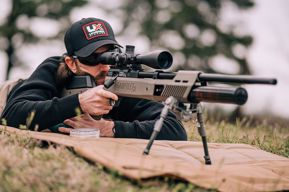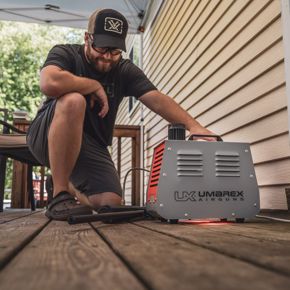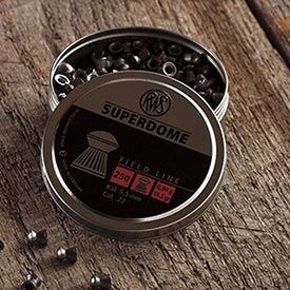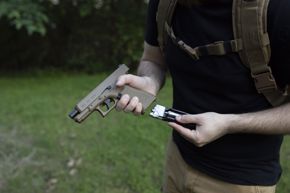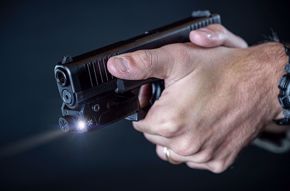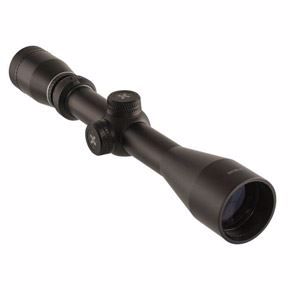Does a Cocked-and-Locked 1911 Strike Fear In You?
Instead of jumping in like I normally would in a gun review, I’d like to begin this piece with the establishment of a basic premise. If you carry a 1911, you need to train with a 1911. This thought scares some away from the battle-tested single-action, but it doesn’t have to. Practice doesn’t have to be dangerous.
The safest, most economical way to practice is with a 1911 that looks, feels, and reacts like a centerfire handgun, but one that won’t put a .45 caliber hole in your foot, your wall, your neighbor’s wall, or your neighbor is an licensed airgun or airsoft replica.
I’ve spent the last two months working with three 1911s from Umarex. I went into the review process looking for the ideal 1911 to train with.
The Elite Force 1911 A1 Airsoft Pistol.
We’ll get into their specifics in a moment, but first I’d like to talk about the 1911’s intimidation factor. In this instance, I’m not referring to how well the gun intimidates bad guys. Enough ink has been spilled on that subject. Instead, I’m talking about the way the words cocked-and-locked can strike fear into those considering daily carry.
The 1911 is a formidable gun. In the right hands, it is a rock star. Some say John Moses Browning’s design is the best handgun ever. The nostalgia factor alone is enough to win fans. And some folks just don’t cotton to plastic handguns.
Yet the cocked-and-locked carry style that the 1911 demands can be dangerous for a novice. Forget that most of the guns have thumb safeties and grip safeties and that some have firing pin blocks. It is intimidating to put a cocked 1911 into a holster and carry it all day. Even though it is completely safe—something I’d argue to my grave—a cocked gun on a novice’s hip has a way of occupying his mind. You could even say it is distracting. Distraction is unsafe.
So you have to practice. I’ve carried a 1911 for more than 10 years, and I’ve never once had an issue. But I practice. And I wish I’d had the Umarex 1911s available to me when I was just starting out. Practicing with an airsoft gun, or with a BB gun will greatly speed up the development of a good single-action skill set.
Let’s start with the basic drills.
Holster Work
You can’t reasonably expect to carry a gun you can’t holster. So we’ll start there.
As always, be safe. Make sure your handgun is unloaded. Check it. Put away the loaded magazines. Check the chamber a second time. Cover all of your bases. This is a basic drill you run dry, (even with a BB gun, at first).
With the gun unloaded, keep your finger off the trigger until your ready to fire. Draw the gun, present to the target. Make sure your support hand comes in clean. Get the finger in the trigger well, aim and dry-fire.
I’ve done countless rotations of this motion. After each, I make sure the gun is cocked and the safety is on, and I re-holster. It is easy, and becomes almost second nature as you build the muscle memory.
You can do this with your actual carry gun, if it doesn’t make you or those around you nervous. I would suggest that a better way would be to practice with an air gun equivalent. That way, there is no chance of catastrophic mistakes.
Concealed Carry
Once you have a good handle on how to get your gun out and back in, I’d suggest you work on the distraction part. There is no better way to familiarize yourself with carrying a gun than to actually carry one. In this case, I’d begin around the house with an air gun, in the privacy of your own home. Wear it in the holster you plan to wear and see how it reacts.
There are some situations that will frustrate a novice carrying a big 1911. Sitting can be awkward. Depending on where you choose to carry, you may bump doorframes with the holstered gun. You might also discover, like we all have, that a simple trip to the John provides some new obstacles. You step in to talk to a man about a horse, next thing you know your gun is clanging down on the tile floor because you weren’t thinking about it when you unfastened your belt.
Carrying a gun can prove distracting. Yet the opposite holds true, too. How do you negotiate using a bathroom in a public place while you are carrying a gun? It sounds asinine as I write it, but someone has to. You need to practice this exact scenario. Make it habitual, so you can focus on shooting.
Time-to-target
An advanced version of this drill requires you to speed up the draw and put a round on target. Again, it is safer to begin this drill with an airsoft or an air gun. Once you get proficient, switch to dry-fire drill with your centerfire handgun. Then add live ammunition at the range.
My favorite scenario is a drill that puts you at point-blank range to the target. Touch it. Get in close. This is useful, as you can try a new drill that you might be hesitant to do with live ammunition. Get up to where your shoulder is touching the target.
The goal is to get back while also eliminating the threat. Be sure you are wearing safety goggles, as BBs and airsoft pellets have a tendency to bounce back. Then shoot while you’re moving. Shoot while backing up. Shoot with the gun beside your rib cage, then extend to the target.
You can even work with those you love and protect everyday. How proficient is your wife with a 1911? Or your husband? Your 10 year old? You may not want them shooting the real thing, but what if they had to? Would they know how one works? These close copies are the best way to talk about guns to people who have little or no experience with them.
Trigger-Time
1911 owners brag endlessly about their guns’ abilities to shoot straight. Even so, you need trigger time. Daily is best. Work on the placement of your trigger finger. Build the muscle memory in your shooting hand on the grip. Work in your support hand carefully, consciously, and make sure you repeat the same patterns every time. You think about these skills during this drill so you won’t have to think about them later.
For this, I’m going to suggest the Umarex Colt Commander. It has a trigger that is more akin to that on a 1911, in that it travels straight back. The trigger on the Colt CQBP hinges and performs more like a trigger on a rifle or a plastic framed handgun.
With the right target set-up, the BB guns and the air soft guns can be fired indoors. As I’ve mentioned before, I have a set-up in the garage that keeps me out of trouble with my wife. Mostly. I take precautions, still; safety glasses are a must. I’ve hardened the target so BBs and pellets won’t punch through, which means airsoft pellets tend to fly back at me.
Keep in mind that shooting a BB gun will never replicate shooting a .45 ACP, you can develop excellent reflexive shooting skills. These air guns are dead on accurate, which makes shooting for accuracy rewarding. But I find the most value in defensive shooting, where I’m attempting to put rounds on target fast, and not string together 1 MOA groups.
Clearing the House
This last element is a must for anyone who owns a 1911 for home defense. And again, I’m going to suggest you begin with the logical safety measures. Stow the centerfire handguns. Lock it up in the safe. Go with the airsoft.
It is best to do this in pairs. Get a friend to go through your house and place some paper bad guys in unexpected places. If it is a really good friend, he’ll put on a coat and a face shield and stand in himself. Then take your air soft 1911 and sweep the house.
Try it in the dark, with a light in one hand and a Elite Force 1911 in the other. You’ll quickly see just how difficult the task actually is. And if you have a willing bad guy stand-in, it will add the adrenaline of an advanced game of hide and seek. If you need even more verisimilitude, arm him with an airsoft gun and have him shoot back.
In the end, there is a wealth of experience to be gained from practicing. The only thing that is not as easily replicated with these guns is the magazine change. 1911 mags are very light when empty. They get sticky when they’re dirty. They’re not as easy to insert as more modern designs, and they have a tendency to stop a gun when they malfunction. You should be practicing mag changes and malfunctions with your 1911, too. I’ve yet to find a great way to do those with these air guns.
Everything else, though, works. These guns fit in 1911 holsters. They weigh about the same. Their sights work and they shoot straight.
David Higginbotham is a writer and educator who lives in Arkansas. After years of writing and consulting in the firearms industry, he's coming back to his roots with air guns.


